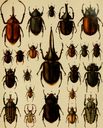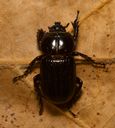Phileurini
Phileurini
Classification
- Phylum: Arthropoda
- Subphylum: Hexapoda
- Class: Insecta
- Order: Coleoptera
- Suborder: Polyphaga
- Superfamily: Scarabaeoidea
- Family: Scarabaeidae
- Subfamily: Dynastinae
- Tribe: Phileurini
Pronunciation
How to pronounce Phileurini: //ˌfaɪ.lɪˈjʊə.raɪ.naɪ//
These audio files are automatically generated. While they are not always 100% accurate, they are a good starting point.
Images






Summary
Phileurini is a tribe of beetles within the Dynastinae subfamily, characterized by their distinctive robust bodies and primarily tropical habitats, comprising over 300 species distributed across 34 genera worldwide.
Physical Characteristics
Phileurini beetles exhibit distinctive features that differentiate them from related groups, typically characterized by their robust bodies and unique coloration patterns.
Identification Tips
Look for their distinctive appearance which varies across species but typically includes a stout body and pronounced horns in males.
Habitat
The Phileurini tribe is found mostly in tropical environments, with some species adapted to areas in the southern regions of our territory.
Distribution
Phileurini are distributed worldwide, primarily in tropical climates. In our area, they are limited to the southern regions.
Diet
While specific dietary preferences may vary among species, members of this tribe commonly feed on decaying organic matter, particularly compost and detritus.
Life Cycle
Detailed data on the specific life cycles of Phileurini is sparse; however, like most beetles, they undergo complete metamorphosis with distinct egg, larval, pupal, and adult stages.
Reproduction
The reproductive behaviors of Phileurini are not well-documented, but it is common for many beetles to exhibit parental care or to bury their eggs in suitable substrates to ensure larval development.
Predators
Natural predators may include birds, mammals, and other larger insects. However, specific predator-prey relationships in Phileurini are not well studied.
Ecosystem Role
As decomposers, Phileurini beetles play an important role in nutrient cycling by breaking down decaying organic material.
Collecting Methods
- Hand collection
- Light trapping
Preservation Methods
- Ethanol preservation
- Pinning
Evolution
The Phileurini are part of the Dynastinae subfamily and represent a lineage that has evolved diverse morphological traits suited for their ecological niches.
Misconceptions
Some individuals may confuse Phileurini with other scarab beetles due to their similar body shapes and sizes.
Tags
- beetles
- Phileurini
- scarbidae
- Dynastinae